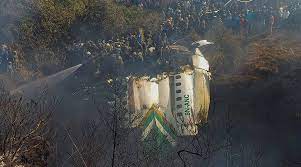Dozens killed after a plane crashed in central Nepal.

The Yeti Airlines flight from Kathmandu to the tourist town of Pokhara crashed on landing before catching fire. Videos posted on social media show an aircraft flying low over a populated area before banking sharply. At least 68 people are confirmed to have died, officials said. Several critically injured survivors were taken to hospital, unconfirmed reports said.

Local resident Divya Dhakal told Newswire how she rushed to the crash site after seeing the aircraft plunge from the sky shortly after 11:00am local time (05:15 GMT).
“By the time I was there the crash site was already crowded. There was huge smoke coming from the flames of the plane. And then helicopters came over in no time,” she said. “The pilot tried his best to not hit civilisation or any home,” she added. “There was a small space right beside the Seti River and the flight hit the ground in that small space.” The flight set out with 68 passengers on board, including at least 15 foreign nationals, and four crew members.

According to flight tracking website Flightradar24, the 15-year-old twin-engine ATR 72 stopped transmitting position data at 05:05 GMT and the last signal from the aircraft was received at 05:12.
Hundreds of Nepalese soldiers were involved in the operation at the crash site in the gorge of the Seti, just one and a half kilometres from the airport. The search operation has been suspended for the day, officials say.

“We expect to recover more bodies,” an army spokesman told Reuters, saying the plane “has broken into pieces”.
Prime Minister Pushpa Kamal Dahal called an emergency meeting of his cabinet and urged state agencies to work on rescue operations. A panel to investigate the cause of the crash has been set up.

Of the passengers, 53 are said to be Nepalese. There were five Indian, four Russians and two Koreans on the plane. There was also one passenger each from Ireland, Australia, Argentina and France among others.
Aviation accidents are not uncommon in Nepal, often due to its remote runways and sudden weather changes that can make for hazardous conditions.





